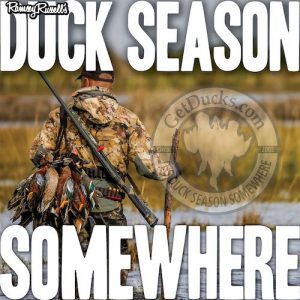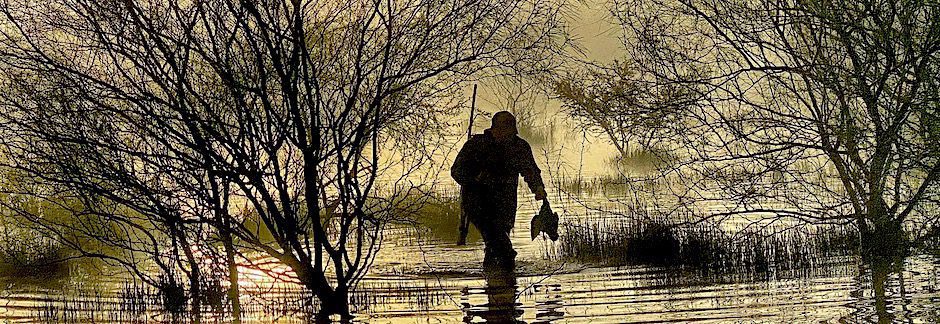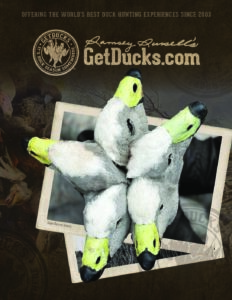MOJO’S Duck Season Somewhere Podcast
Experiencing Real South African Wingshooting, Part 2

It’s a chilly night in South Africa. Ramsey Russell and longtime Professional Hunter Mike Currie are huddled around a crackling fireplace with some of the best bird dogs on earth as their conversation about experiencing real South African wingshooting continues. Getting down to the nitty-gritty of a proper South Africa duck hunting combo, they run through a variety of fun subjects to include driven guineafowl, francolin, Currie’s prized pointers and Ramsey’s favorite, those big ol’ spur-winged geese! South Africa is among the top shotgunning destinations on earth whether for species collecting, trigger pulling or both, but above all else, it’s just a flat-out uniquely awesome experience.
Related Topics:
Everything but the Squeal in Southwest Louisiana

Boudin is a south Louisiana cultural staple and everyone has their favorites. Find fresh-made boudin and you’ll find all kinds of uniquely south Louisiana pork delicacies for which the region is truly famous. What is cajun boudin and how does it differ from place to place? How’d it become so deeply rooted in Louisiana culture? Where’d the recipe for one of Ramsey’s favorites originate and why’s it different than some others? How much boudin sausage is made daily in this rural farming community? What’s the best way to prepare it at home? What other parts of the pig are eaten? Roger Laughlin owns Mr. T’s in Elton, Louisiana. Following a blue-winged teal hunt, he tells Ramsey about the making of boudin, other smoked meats and favorite duck recipes, sharing an authentic taste of south Louisiana’s culture. Question to listeners: who makes your favorite Louisiana boudin?
The Gatherin’ Girl Mixes Art, Food and Nature

Free spirit Tori Loomis grew up across the river from historical Natchez, Mississippi, where she now lives, plying her trade and paying her dues in the service industry. Formally trained in culinary arts, her lifestyle is an immersive combination of art, food and nature. How did culinary arts school conflict with her upbringings, and what valuable skillsets did she walk away with? What’s her connection to food, what human connections influenced her? How does eating engage all of our senses? How is cooking as artform, and how does hunting inspire her? How are recipes as instinctual as art? Walking Ramsey through her recipes used preparing lunch, Loomis ties it all together perfectly. Great meals pay tribute to hunting and to the game hunted. As hunting season nears, the gatherin’ girl Tori Loomis shares her craft in a way we can all sink our teeth into it. Bon appétit.
Experiencing Real South Africa Wingshooting, Part 1

Long-time friend and Professional Hunter, Mike Currie, joins Ramsey for a fireside chat about South Africa wingshooting–and whole lots more! Africa hunting conjures images of stalking spiral-horned game animals or fending off charging lions. What was it really like growing up on a South African farm? When did Currie know he wanted to be a PH? What all goes into delivering South Africa hunting experiences? How does hunting the Cameroon jungle differ from South Africa, what is working with pygmies like, and how do pygmies estimate elephant tusk size when visibility is limited to scarcely more than only arm’s length? A passionate and colorful storyteller, Currie portrays experiencing Real Africa in part one of this 2-part conversation.
Related Topics:
The Gift to See It, Lee Kjos

Long before BOSS Shotshells, Lee Kjos had established himself foremost among commercial photographers, working with a long list of the the hunting world’s hottest brands. At lister’s requests, today we explore this fascinating subject of meaningful influence. What is it an iconic photo and when do you really know it’s great? What do such photos do? What photos most stand out in Kjos’s career (bet you’ll remember them too)? What’s the difference in photo journalism and commercial art? Can truly iconic photos be contrived? In this modern era, with thousands of photos cascading through our social media feeds daily, is a photo really still worth a thousand words–or are some possibly worth a whole lot more? Something to think about as we begin snapping photos our own hunting seasons.
September Teal Today, Gone Tomorrow

It’s that special time of year again, the September blue-winged teal season is underway. Following a typical teal hunt at their South Delta Mississippi camp, Ramsey Russell, Mr. Ian and Forrest remember hunts together from the past 20 years, discussing likes and dislikes about blue-winged teal hunting in a deep south flyway state. Ramsey starts his 2021-22 North American waterfowl tour next week, stay tuned for upcoming stories from the road.
Retired Green Scorpion Stories, South Africa

In retirement, perpetually smiling Werner Böing helps orchestrate driven guineafowl and rock pigeon hunts, flipping South Africa’s best hamburgers with catcher’s mitt-sized hands. Formerly, he was for decades among South Africa’s most elite environmental task force, the Green Scorpions. What drives someone like Böing, what lead him into this career path? What species kept them busiest, how were covert operation orchestrated, taking them at times into Southeastern Asia? What international agencies were involved? Why’d he quit Sunday investigations (I would have too)? What role does hunting play in the greater scheme of things, and what will become of South Africa’s most iconic species? A man of few words, Böing offers thought-provoking insights as deftly as a charging rhino.
Related Topics:
The Real New Year’s Day: Delta Dove Hunting, Other Stories

To migratory bird hunters, Labor Day marks the real New Year. Summer temps are finally waning, cotton defoliant wafting on soon-to-be-autumn air. It’s finally dove season. Everything else soon follows. Mississippi Delta native Chuck Cage has been guiding since the late ’70s, only recently retiring. He and Ramsey discuss dove hunting, duck hunting and lots more in today’s Duck Season Somewhere episode. How’d he accidentally get into guiding duck hunters in the Mississippi Delta, how big is his traditional hunting area? What’s he mean saying “traders of tradables” was once his business card title, what was his motto, and what’s the most memorable thing ever delivered as promised? After all these years, how many leg bands hang from his lanyard, and what are his thoughts on the subject? What’s changed since the days he hunted first with his grandfather? How’s guiding sometimes mediating? Like a mourning dove streaking across a hot sunflower field, barrel-rolling at the shots unscathed, they cover a lot of interesting ground about one of the most iconic Mississippi Delta hunters and outfitters.
“Stinking the Pot” in Louisiana

“Stinking da’ pot.” That’s how Chris Meche describes making traditional South Louisiana gravy. His is best-of-the-best. World-class. After getting a duck and sausage gravy started, then prepping a mile-long countertop worth of sides, he describes growing up in South Louisiana, taking Ramsey on a cultural tour of good eats. How’d Meche get started hunting and what was his first “duck”? Where’d he learn to cook and why’s it still important to him? What’re “shoe-pick patties”? What’s the proper way to make gravy, how many beers does it take? When does the duck camp experience start? Like a “30-weight gravy” over sticky white rice at duck camp dinner, just an easy going conversational episode among a couple hunting buddies that’ll really stick to your bones.
A Taste of South Africa

Following an exciting day shooting driven guineafowl and “rockies” in Free State, South Africa, Pierre Aucamp and Ramsey Russell talk about South Africa bird hunting. What is South African hunting like for locals? In a country predominated by game animals, what attracted Pierre to bird hunting? How important is hunting tourism to South Africa and what’s Pierre’s business model? Any favorite guineafowl and dove recipes? Besides GSPs, any other interesting critters around his home? Stay tuned. This episode begins an 8-part South Africa series covering a wide variety of interesting and informative topics – like standing post on a driven guineafowl hunt, there’s no telling what’s fixing to bust from cover and cannonball overhead!
Related Topics:








